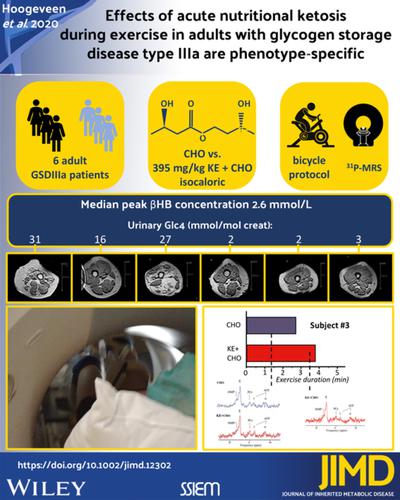当前位置:
X-MOL 学术
›
J. Inherit. Metab. Dis.
›
论文详情
Our official English website, www.x-mol.net, welcomes your feedback! (Note: you will need to create a separate account there.)
Effects of acute nutritional ketosis during exercise in adults with glycogen storage disease type IIIa are phenotype‐specific: An investigator‐initiated, randomized, crossover study
Journal of Inherited Metabolic Disease ( IF 4.2 ) Pub Date : 2020-08-16 , DOI: 10.1002/jimd.12302 Irene J Hoogeveen 1 , Foekje de Boer 1 , Willemijn F Boonstra 1 , Caroline J van der Schaaf 1 , Ulrike Steuerwald 2 , Anita J Sibeijn-Kuiper 3 , Riemer J K Vegter 4 , Johannes H van der Hoeven 5 , M Rebecca Heiner-Fokkema 6 , Kieran C Clarke 7 , Pete J Cox 7 , Terry G J Derks 1 , Jeroen A L Jeneson 3, 8
Journal of Inherited Metabolic Disease ( IF 4.2 ) Pub Date : 2020-08-16 , DOI: 10.1002/jimd.12302 Irene J Hoogeveen 1 , Foekje de Boer 1 , Willemijn F Boonstra 1 , Caroline J van der Schaaf 1 , Ulrike Steuerwald 2 , Anita J Sibeijn-Kuiper 3 , Riemer J K Vegter 4 , Johannes H van der Hoeven 5 , M Rebecca Heiner-Fokkema 6 , Kieran C Clarke 7 , Pete J Cox 7 , Terry G J Derks 1 , Jeroen A L Jeneson 3, 8
Affiliation

|
Glycogen storage disease type IIIa (GSDIIIa) is an inborn error of carbohydrate metabolism caused by a debranching enzyme deficiency. A subgroup of GSDIIIa patients develops severe myopathy. The purpose of this study was to investigate whether acute nutritional ketosis (ANK) in response to ketone‐ester (KE) ingestion is effective to deliver oxidative substrate to exercising muscle in GSDIIIa patients. This was an investigator‐initiated, researcher‐blinded, randomized, crossover study in six adult GSDIIIa patients. Prior to exercise subjects ingested a carbohydrate drink (~66 g, CHO) or a ketone‐ester (395 mg/kg, KE) + carbohydrate drink (30 g, KE + CHO). Subjects performed 15‐minute cycling exercise on an upright ergometer followed by 10‐minute supine cycling in a magnetic resonance (MR) scanner at two submaximal workloads (30% and 60% of individual maximum, respectively). Blood metabolites, indirect calorimetry data, and in vivo 31P‐MR spectra from quadriceps muscle were collected during exercise. KE + CHO induced ANK in all six subjects with median peak βHB concentration of 2.6 mmol/L (range: 1.6‐3.1). Subjects remained normoglycemic in both study arms, but delta glucose concentration was 2‐fold lower in the KE + CHO arm. The respiratory exchange ratio did not increase in the KE + CHO arm when workload was doubled in subjects with overt myopathy. In vivo 31P MR spectra showed a favorable change in quadriceps energetic state during exercise in the KE + CHO arm compared to CHO in subjects with overt myopathy. Effects of ANK during exercise are phenotype‐specific in adult GSDIIIa patients. ANK presents a promising therapy in GSDIIIa patients with a severe myopathic phenotype.
中文翻译:

运动期间急性营养酮症对 IIIa 型糖原贮积病成人的影响具有表型特异性:一项由研究者发起的随机交叉研究
糖原贮积病 IIIa 型 (GSDIIIa) 是由脱支酶缺乏引起的碳水化合物代谢的先天性错误。一部分 GSDIIIa 患者出现严重的肌病。本研究的目的是调查响应于酮酯 (KE) 摄入的急性营养性酮症 (ANK) 是否能有效地将氧化底物输送到 GSDIIIa 患者的锻炼肌肉中。这是一项在六名成年 GSDIIIa 患者中进行的由研究者发起、研究者设盲的随机交叉研究。运动前受试者摄入碳水化合物饮料(~66 g,CHO)或酮酯(395 mg/kg,KE)+碳水化合物饮料(30 g,KE + CHO)。受试者在直立式测力计上进行 15 分钟的自行车运动,然后在磁共振 (MR) 扫描仪中进行 10 分钟的仰卧骑行,并以两种次最大工作负荷(分别为个人最大负荷的 30% 和 60%)。血液代谢物、间接量热数据和体内在运动过程中收集了来自股四头肌的31 个P-MR 光谱。KE + CHO 在所有 6 名受试者中均诱导 ANK,βHB 峰值浓度中位数为 2.6 mmol/L(范围:1.6-3.1)。两个研究组中的受试者均保持正常血糖,但 KE + CHO 组中的 delta 葡萄糖浓度低 2 倍。当患有明显肌病的受试者的工作量加倍时,KE + CHO 组的呼吸交换比没有增加。体内31 P MR 谱显示,在患有明显肌病的受试者中,与 CHO 相比,KE + CHO 臂在运动过程中股四头肌的能量状态发生了有利的变化。运动期间 ANK 的影响在成人 GSDIIIa 患者中具有表型特异性。ANK 为具有严重肌病表型的 GSDIIIa 患者提供了一种有希望的治疗方法。
更新日期:2020-08-16
中文翻译:

运动期间急性营养酮症对 IIIa 型糖原贮积病成人的影响具有表型特异性:一项由研究者发起的随机交叉研究
糖原贮积病 IIIa 型 (GSDIIIa) 是由脱支酶缺乏引起的碳水化合物代谢的先天性错误。一部分 GSDIIIa 患者出现严重的肌病。本研究的目的是调查响应于酮酯 (KE) 摄入的急性营养性酮症 (ANK) 是否能有效地将氧化底物输送到 GSDIIIa 患者的锻炼肌肉中。这是一项在六名成年 GSDIIIa 患者中进行的由研究者发起、研究者设盲的随机交叉研究。运动前受试者摄入碳水化合物饮料(~66 g,CHO)或酮酯(395 mg/kg,KE)+碳水化合物饮料(30 g,KE + CHO)。受试者在直立式测力计上进行 15 分钟的自行车运动,然后在磁共振 (MR) 扫描仪中进行 10 分钟的仰卧骑行,并以两种次最大工作负荷(分别为个人最大负荷的 30% 和 60%)。血液代谢物、间接量热数据和体内在运动过程中收集了来自股四头肌的31 个P-MR 光谱。KE + CHO 在所有 6 名受试者中均诱导 ANK,βHB 峰值浓度中位数为 2.6 mmol/L(范围:1.6-3.1)。两个研究组中的受试者均保持正常血糖,但 KE + CHO 组中的 delta 葡萄糖浓度低 2 倍。当患有明显肌病的受试者的工作量加倍时,KE + CHO 组的呼吸交换比没有增加。体内31 P MR 谱显示,在患有明显肌病的受试者中,与 CHO 相比,KE + CHO 臂在运动过程中股四头肌的能量状态发生了有利的变化。运动期间 ANK 的影响在成人 GSDIIIa 患者中具有表型特异性。ANK 为具有严重肌病表型的 GSDIIIa 患者提供了一种有希望的治疗方法。


























 京公网安备 11010802027423号
京公网安备 11010802027423号